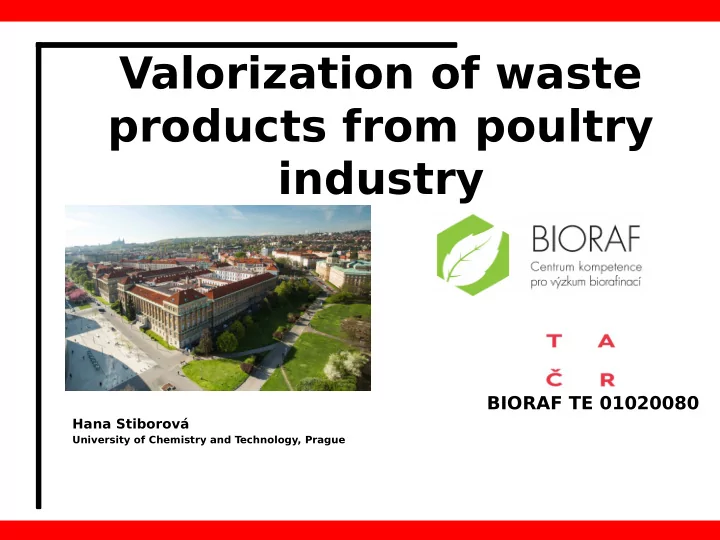

Valorization of waste products from poultry industry BIORAF TE 01020080 Hana Stiborová University of Chemistry and Technology, Prague
Why waste from poultry industry? Enormous amount of waste products Possibilities of waste re-
World chicken production 140 120 100 Million tons 80 60 40 20 0 Africa Americas Asia Europe Oceania World 2000 2005 2010 2014 2017 Global poultry trends ,2014, 2018
Poultry waste products Slaughter yields 71 - 79% Chicken waste products: 1. Feather (6-9% of weight of chicken) 2. Skin 3. Organs ( e.g . intestine, lung) 4. Claws 5. Fat 6. Blood 7. Waste mixture after mechanical deboning (6-8% of weight of chicken)
Feather waste The feather production Czech Republic - around 12 thousand of tonnes annually Worldwide - around 6-8 millions of tonnes annually What happens with feather? Feather composition - Over 90% protein, majority is beta-keratine, insoluble structural protein - Fat 2%
Raw feather hydrolysis Whole cell microbial hydrolysis - using strains with keratinolytic activities Enzymatic hydrolysis - using semipurifjed keratinase Chemical hydrolysis Compare the - using mild alkali condition hydrolysates - 0.6% of NaOH, 70 ° C
Feather hydrolysates Type of Amino acids Peptides [g/L] hydrolysis [g/L] Pseudomona s sp. P5 0.30 ± 0.03 6.2 ± 0.2 (A) Pseudomonas sp. P5 0.27 ± 0.07 4.6 ± 0.1 (B) Keratinase (A) 1.05 ± 0.15 3.2 ± 0.2 Keratinase (B) 1.09 ± 0.08 3.3 ± 0.2 Alkali cond. (A) 0.33 ± 0.05 17.2 ± 2.6 Alkali cond. (B) 0.38 ± 0.02 14.3 ± 0.1 A - The initial amount of wet raw feather material was 90 g/L (31.9 g of dry feather /L). B - The initial amount of wet raw feather material was 70 g/L (24.9 g of dry feather g/L).
Hydrolysates – source of nutrients for bacterial growth Hydrolysates – sterilized, neutralized with HCl (alkali hydrolysis) T ested microorganism – Escherichia coli Biomass concentration measured for 48 h on Bioscreen system 0,9 0,8 0,7 OD (600 nm) 0,6 0,5 0,4 0,3 0,2 0,1 0 0 5 10 15 20 25 30 35 40 45 50 Time (h) Hydrolyzates obtained by Alkali, Enzymatic, Microbial Luria-Bertani broth, Control - unhydrolyzed feather
Alkaline hydrolysis – semi-scale operation 5 L volume T emperature70 ° C 0.6% NaOH Dispensator Ultra-T urrax T50 Feather hydrolysis 90% Before hydrolysis After hydrolysis
Conclusions – feather re-utilization Application of hydrolysates: - Organic fertilizers - Peptone substituent in a culture media - Low cost supplements - In cosmetics Publication: Stiborova H., et al .: Transformation of raw feather waste into digestible peptides and amino acids ., J. Chem. T echnol. Biotechnol. 2016, 91: 1629-1637 Patent: PV 2015-102: Complete cultivation medium for production of ethanol or butanol, its production ways and production ways of ethanol or butanol - Patakova P ., et al.
Waste after mechanical deboning Waste after mechanical deboning - 6-8% weight of chicken Contain - cartilage, bones and skin and meat Wast Mechanical separator e
Process of bioactive compounds isolation Waste after mechanical deboning Filtration of the hydrolyzate through kieselguhr Phosphate bufger Product concentration Sterilization Lyofjlization or drying Hydrolysis - papain Product - CHONDROMIX Enzyme inactivation Removal of unhydrolyzed parts Chondroitin, hyaluronic acid, peptides, Fat separation amino acids
Product CHONDROMIX - processing scale-up Product CHONDROMIX Lab-scale: 10 g of waste Lab-scale: 60 - 600 g of waste Product Semi-scale: 25 kg of CHONDROMIX waste
Process optimization - to obtain minimum 10% of hydrolyzate (containing at least 10% hyaluronic acid) A A B C Process optimization - Expert Design 8 A – volume of bufger/60 g of waste material tested from 36 to 84 ml B – amount of enzyme (papaine)/60 g of waste material tested from 14.4 mg to 60 mg/60 g of waste material C A C - time of hydrolysis tested from 3 to 15 hrs
Products comparision CHONDROMIX Pure cartilage mixture product Source – waste after Source – pure mechanical deboning cartilage Patent - WO2012143324 Patent - PV 2016-788 Mixture Mixture - chondroitin sulfate 15% - 25% (w/w) - chondroitin sulfate 6% - 17% (w/w) - - hyaluronic acids 0.1-1.0% (w/w) hyaluronic acids 10 - 15% (w/w) - - protein and peptides 67% - 87% (w/w) protein and peptides 60% - 80% (w/w) - amino acids up to 3% Stiborova et al. Waste products from the poultry industry: a source of high-value dietary supplements , J. Chem. T echnol. Biotechnol., accepted
Founding and team collaboration Founded by Technological Agency of the Czech Republic - project BIORAF TE 01020080 Teams from University of Chemistry and Technology Group of prof. Demnerová – Dr. Hana Stiborová, doc. Dr. Petra Lovecká Group of prof. Melzoch – doc. Dr. Petra Patáková, Dr. Barbora Branská, Dr. Leona Paulová Group of prof. Hajšlová and prof. Poustka – doc. Dr. Milena Zachariášová, Dr. Monika Jírů Ecofuel Laboratory s.r.o . - Dr. Petr Kaštánek and Ing. Olga Kronusová
Product CHONDROMIX – from waste after mechanical deboning Yields of waste processing bones fat 6,00% 6,00% 6,00% dried waste (proteins, Product - bones<0.2 mm) 11,00% CHONDROMIX 61,00% CHONDROMIX 10,00% loss water
Recommend
More recommend